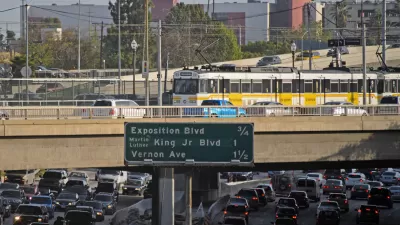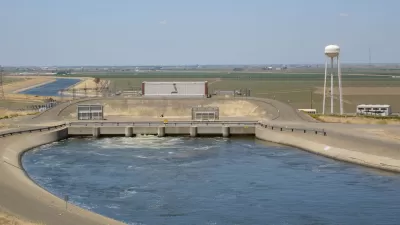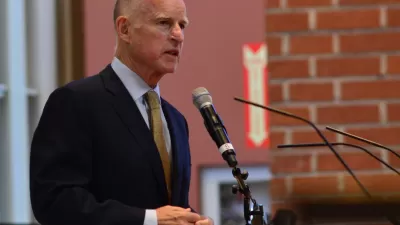An earlier announcement awarded almost $400 million to transit agencies, but left a larger chunk of these funds still unsettled. On Wednesday, leaders agreed on a $900 million expenditure plan to cut emissions and address social concerns.

Governor Edmund G. Brown Jr., Senate President pro Tempore Kevin de León (D-Los Angeles) and Assembly Speaker Anthony Rendon (D-Paramount) announced an agreement on Aug. 31 on an expenditure plan for $900 million of nearly $1.4 billion in unallocated cap-and-trade proceeds "for fiscal year 2016-17", and setting aside "approximately $462 million for appropriation in future years."
Funds will go to a wide variety of projects that address the dual needs of reducing carbon emissions and prioritize investment in communities most impacted by air pollution, such as "new park space and pedestrian-friendly affordable housing."
This agreement aligns with the state's climate strategies to reduce emissions, petroleum consumption and short-lived climate pollutants, while bolstering renewable energy and energy efficiency programs. It also targets investment in disadvantaged communities disproportionately impacted by dirty air and carbon pollution and transportation-related programs, as transportation represents the largest source of greenhouse gas emissions
The legislature acted quickly by passing AB-1613: Budget Act of 2016 on the final day of the 2015-2016, two-year legislative session. Initially the bill called for allocating $1.2 billion to the expenditure plan.
The $391 million allocated to 14 transit projects on Aug. 16 originated from the "60 percent of annual [cap-and-trade] auction proceeds [that] are allocated on an ongoing basis to public transit, affordable housing, sustainable communities and high-speed rail."
For the last two years, the governor and legislative leaders have been unable to reach agreement on how to spend the remaining 40 percent, until Wednesday. During that time, this unallocated pot of auction proceeds known as the Greenhouse Gas Reduction Funds (or California Climate Investments) has grown to $1.362 billion.
Electric vehicle incentives, even for low income motorists
The California Air Resources Board (CARB) will be the biggest recipient with $368 million, which includes $133 million going to replenish the Clean Vehicle Rebate Program so motorists can receive rebates of $1,500, $2,500 and $5,000 when they buy Chevy Volts, Teslas, and Toyota Mirai Fuel Cell Vehicles, respectively, though there are income guidelines.
An additional funds $80 million was allocated to CARB to fund the "Enhanced Fleet Modernization Program and Plus-Up Pilot Project in the Greater Los Angeles area and San Joaquin Valley to help people of low income replace old, polluting cars with cleaner, more fuel efficient vehicles that also cut greenhouse gas emissions. Under the program, it is possible for a family that meets income guidelines to receive as much as $12,000 toward the purchase of an electric car." Eligible residents who choose not to replace their vehicle can also opt for "public transit passes valued at between $2,500 and $4,500, depending on their income."
Planning
The Office of Planning and Research for the Strategic Growth Council will determine where to direct $140 million in "transformative climate communities grants." Low income communities will be targeted for investment.
"Communities across our state are already experiencing the harmful effects of climate change and air pollution...," said Senate President pro Tempore De León.... "I'm pleased that we've reached a deal to bring relief and access to clean energy to the communities that need it most.."
"The spending proposal is tilted toward urban areas and low-income communities, marking a win for lawmakers who argued their poorer constituents were being left out of the largesse generated by the cap-and-trade program," report Melanie Mason and Liam Dillon for the Los Angeles Times.
A complete list of the expenditure plan is located at the bottom of the press release, which notes that total
"[c]ap-and-trade investments in California, including expenditures in today's agreement, total $3.2 billion." The first auction was held in November 2012.
However, cap-and-trade faces an uncertain future, with dwindling revenues and fighting a lawsuit that could end the program. The August auction brought in only about $8 million, $2 million less than the May auction, according to Mason and Dillon.
FULL STORY: Governor Brown, Legislative Leaders Announce Cap-And-Trade Expenditure Plan Agreement

Planetizen Federal Action Tracker
A weekly monitor of how Trump’s orders and actions are impacting planners and planning in America.

Restaurant Patios Were a Pandemic Win — Why Were They so Hard to Keep?
Social distancing requirements and changes in travel patterns prompted cities to pilot new uses for street and sidewalk space. Then it got complicated.

Map: Where Senate Republicans Want to Sell Your Public Lands
For public land advocates, the Senate Republicans’ proposal to sell millions of acres of public land in the West is “the biggest fight of their careers.”

Maui's Vacation Rental Debate Turns Ugly
Verbal attacks, misinformation campaigns and fistfights plague a high-stakes debate to convert thousands of vacation rentals into long-term housing.

San Francisco Suspends Traffic Calming Amidst Record Deaths
Citing “a challenging fiscal landscape,” the city will cease the program on the heels of 42 traffic deaths, including 24 pedestrians.

California Homeless Arrests, Citations Spike After Ruling
An investigation reveals that anti-homeless actions increased up to 500% after Grants Pass v. Johnson — even in cities claiming no policy change.
Urban Design for Planners 1: Software Tools
This six-course series explores essential urban design concepts using open source software and equips planners with the tools they need to participate fully in the urban design process.
Planning for Universal Design
Learn the tools for implementing Universal Design in planning regulations.
Heyer Gruel & Associates PA
JM Goldson LLC
Custer County Colorado
City of Camden Redevelopment Agency
City of Astoria
Transportation Research & Education Center (TREC) at Portland State University
Camden Redevelopment Agency
City of Claremont
Municipality of Princeton (NJ)





























